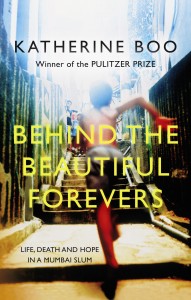However we connect with the city, there is always more to know. The same can be said for everything in life as we stumble, walk, glide through, facing lessons, surprises, pain, joy and loss. The emotions and lessons are the same, no matter how different the form of the lesson.
This is what resonated through Behind the Beautiful Forevers.
Written by David Hare, Behind the Beautiful Forevers is based Katherine Boo’s book exploring Annawadi, a slum situated on Mumbai Airport land. The play fiercely portrayed the life stories of Annawadi inhabitants and through doing so, uncovering the human aspect of economical exploitation and corruption. The slum becomes a heaving collective body brought alive by the direction (Rufus Norris) through which human emotion is prised out. As a shadow of a plane glides over the audience and stage, the roar emphasises the reality of what is being enacted on stage.
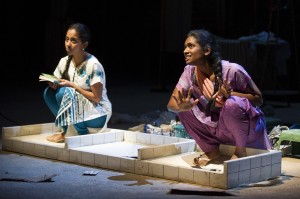 The horror of injustice. The struggle. The things we in the West take for granted. The inhuman exploitation of human rights. “Why is this still happening in the world?” is a question you will find yourself asking.
The horror of injustice. The struggle. The things we in the West take for granted. The inhuman exploitation of human rights. “Why is this still happening in the world?” is a question you will find yourself asking.
The play is disturbing at times as raw emotion, human vulnerability and inequality brims over. Uncomfortably. It is certainly not for the faint hearted. Garbage sorter Abdul Husain (Shane Zaza) states: “I tell Allah I love Him… But I cannot be better, because of the way the world is.” Nonetheless, Abdul is a character who makes the powerful choice to do what feels right.
Another character observes: “If you do not think it is wrong, then it isn’t.” It is about survival in the big bad world but also about facing yourself, about not running but facing one’s conscience.
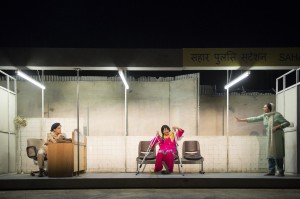 Power is a constant theme. The Government’s “umbrella” abuse of power is expected in any medium exploring a “slum”. But the power struggle within the actual slum was explored in depth. It became clear that power struggle within the slum is multi layered – religion, physical appearance, wealth, gender all have a part to play.
Power is a constant theme. The Government’s “umbrella” abuse of power is expected in any medium exploring a “slum”. But the power struggle within the actual slum was explored in depth. It became clear that power struggle within the slum is multi layered – religion, physical appearance, wealth, gender all have a part to play.
However what was illuminating and stepped away from clichés was woman power. Women held the reigns, controlling how the slum is run, how their families are run. Women are portrayed as a paradox – simultaneously sacrificial and powerful.
There is no right answer on how to be or what the right way is. The slum inhabits families who depend on one another yet fiercely hold onto their independence. They crave to be more powerful than their neighbour – not to be vulnerable, so open to damage that their neighbour is able to inflict.
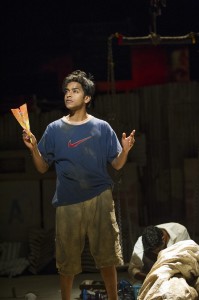 Abdul Husain is the best garbage sorter in the slum. We see him crouched over, separating different materials, sifting money from trash. His mother Zehrunisa is an overpowering, bullying, boss of a woman. However, we soon see beneath Zehrunisa’s defensive demeanour as life begins to unfold in very unexpected ways. Fatima is a disabled woman known as “one leg”. She works as a prostitute from home and refuses to see herself as a victim. To the insults she states she is in control because she has a choice – a choice of whom she allows and rejects.
Abdul Husain is the best garbage sorter in the slum. We see him crouched over, separating different materials, sifting money from trash. His mother Zehrunisa is an overpowering, bullying, boss of a woman. However, we soon see beneath Zehrunisa’s defensive demeanour as life begins to unfold in very unexpected ways. Fatima is a disabled woman known as “one leg”. She works as a prostitute from home and refuses to see herself as a victim. To the insults she states she is in control because she has a choice – a choice of whom she allows and rejects.
These 3 characters were the backbone of the play in terms of performance and storyline. The 3 become intimately connected and catalysts for one another’s fate.
In terms of performance Meera Syal as Zehrunisa Husain, Shane Zaza as Abdul Husain and Thusitha Jayasundera as Fatima or “one leg” shook the audience to the bone with spectacular, genuine and haunting performances.
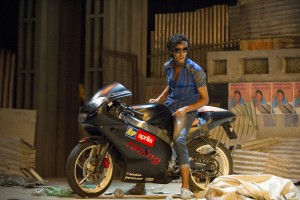 The harsh reality of the slum contrasted sharply against the “beautiful” Bollywood themes. Bollywood music is the makeup, the backdrop of the play. We are introduced to new scenes accompanied with Bollywood. At times Bollywood music drifts out from a small hut on stage as dramas unfold.
The harsh reality of the slum contrasted sharply against the “beautiful” Bollywood themes. Bollywood music is the makeup, the backdrop of the play. We are introduced to new scenes accompanied with Bollywood. At times Bollywood music drifts out from a small hut on stage as dramas unfold.
At one instant a slum dweller complains about the Bollywood promotions to keep litter off Mumbai streets. This is instantly seen as direct threat to the livelihood of the garbage pickers. It is suggested that the “poorer” less glamorous reality of India has no space in the developing image.
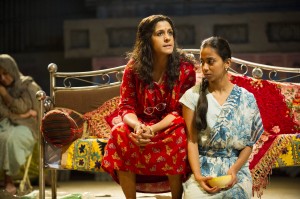 The slum dweller is ultimately powerful as long as they won’t give up their space and “allow” India to develop in the eyes of the world. A question provoked is: who is really barricading whom to flourish?
The slum dweller is ultimately powerful as long as they won’t give up their space and “allow” India to develop in the eyes of the world. A question provoked is: who is really barricading whom to flourish?
There is still deeper symbolism. Bollywood is romantic. Escapist. A song and dance. Is Bollywood covering up the pain of the poorer Indian? Hiding the poorer Indian? An industry with a turnover of millions, the economic injustice is almost too painful to acknowledge.
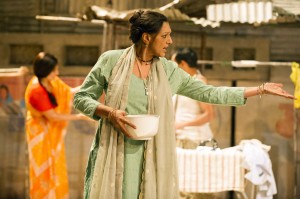 But then, the play portrays Bollywood as serving the slum dweller; almost a remedy for survival. The Bollywood song becomes a form of expression, giving a sense of power as a slum dweller punches out some dance moves.
But then, the play portrays Bollywood as serving the slum dweller; almost a remedy for survival. The Bollywood song becomes a form of expression, giving a sense of power as a slum dweller punches out some dance moves.
I felt an anger surge through me. Is this play all about the “slum clichés” we are all too familiar with? I know slum life is difficult and a struggle. I know girls are struggling to get an education, that prostitution becomes the answer for income. I know about the corrupt, scary policeman and about murders being covered up.
 This surging anger was my sense of (ir)responsibility – the sickening question of injustice; why is this still happening, still taking place? And then the conclusion of can we really make a difference? Or is this just how the world is?
This surging anger was my sense of (ir)responsibility – the sickening question of injustice; why is this still happening, still taking place? And then the conclusion of can we really make a difference? Or is this just how the world is?
Behind the Beautiful Forevers uncovering the humanness of the slum by making the audience see the human behind statistic and thus, makes a difference. Woman power. The hope and dream to survive. The internal moral awakening that must be chosen. Or rejected. It is stepping into the stereotype and then stepping away from the stereotype that makes Behind the Beautiful Forevers hauntingly powerful.
Watch author Katherine Boo and Meera Syal talk about the real lives behind the play:
The new production is running at the National Theatre from 19th November, and is currently booking until 13th April. Part of the Travelex £15 Tickets season, half the tickets for every performance are £15. It will be broadcast to UK cinemas by National Theatre Live on 12th March. Book a performance:
http://www.nationaltheatre.org.uk/shows/behind-the-beautiful-forevers
Images by Richard Hubert Smith; Courtesy of Media Moguls

